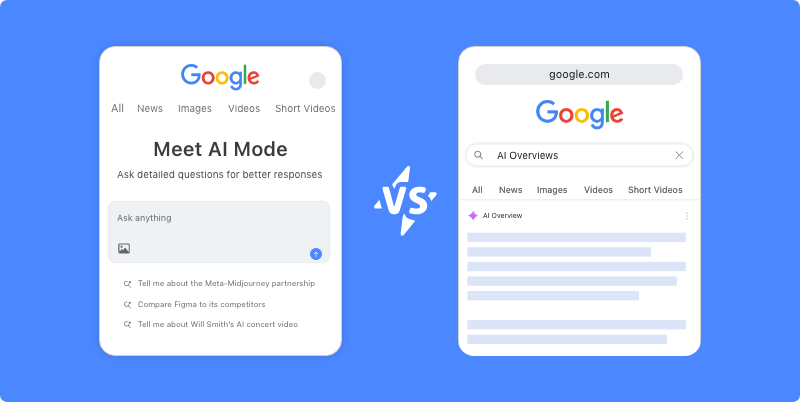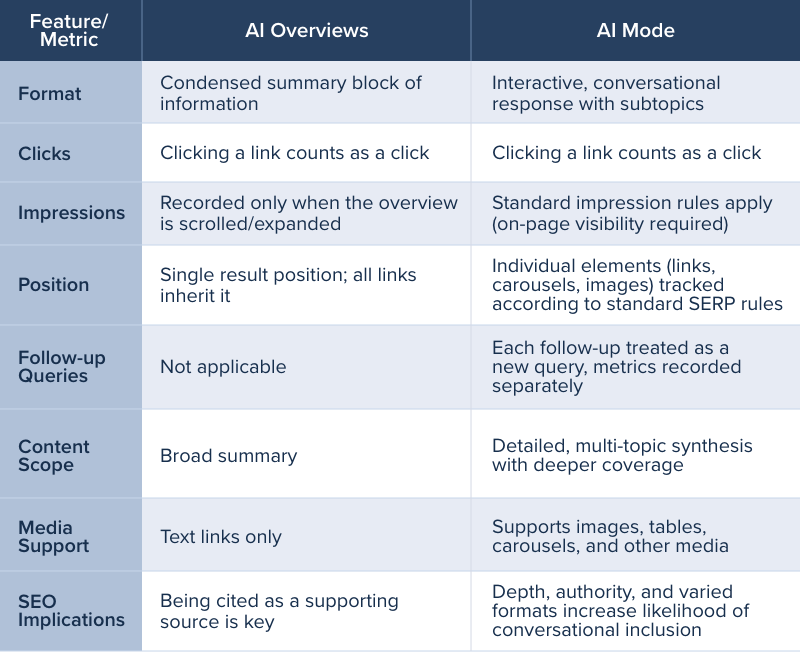Google is in the middle of one of the biggest changes to Google Search functionality in its history. The familiar list of blue links is being pushed ever further down the page by AI-generated summaries and interactive responses, and many users now have the option to conduct a 100% AI-based search.
For SEOs and site owners, this raises an obvious question: how do these new features affect visibility, clicks, and reporting?
The two main AI experiences currently in play within Google Search are AI Overviews and AI Mode. At a glance they look similar: both surface AI-generated answers with supporting links, but under the hood, they work differently. Understanding those differences is important for interpreting SEO performance and adjusting SEO strategies accordingly as Google Search moves deeper into its AI era.

What AI Overviews Are
AI Overviews are Google's first wave of generative search results. When triggered, they appear as a block near the top of the results page, providing a condensed summary of information stitched together from multiple sources. Within the summary, Google highlights links to external websites that support or expand on the information presented.
Here's what you need to know about AI Overviews from a SEO metrics standpoint:
- Clicks: If a user clicks on one of the links surfaced inside the AI Overview, it is counted as a click for that webpage.
- Impressions: An impression is only recorded when the AI Overview is scrolled into view or expanded by the user.
- Position: The AI Overview is treated as a single result in search. All of the links it contains inherit the same position in reporting, regardless of where they appear within the overview itself.
This setup means visibility inside an AI Overview is less about individual ranking positions and more about whether or not your content is selected as one of the supporting resources.
What AI Mode Adds
AI Mode builds on the concept of AI Overviews but takes the experience further. Instead of a single block of information, AI Mode feels more like an interactive conversation layered into search results.
When a user chooses to browse using AI Mode and types a query in, Google's systems break it down into subtopics and run multiple searches in parallel. The results are synthesized into a longer, more detailed answer, often supplemented with carousels, images, or structured breakdowns. External links are surfaced throughout the response, allowing users to click through to supporting sources or dive deeper into related topics.
There are a few key similarities and differences between AI Overviews and AI Mode to understand for SEO reporting:
- Clicks: Clicking an external link inside AI Mode counts as a click, just as it does in AI Overviews.
- Impressions: Standard impression rules apply. If your link appears and is scrolled into view, it's logged.
- Position: Unlike AI Overviews, position reporting in AI Mode follows the same methodology as traditional Google results. Carousels, image blocks, and text elements each get positions calculated according to the existing rules for those features.
- Follow-up Queries: One of the most important distinctions between AI Overviews and AI Mode is that AI Mode allows follow-up questions. Each new question is treated as a brand-new query. Any impressions, positions, or clicks from that exchange are attributed to the new query rather than the original.
For SEOs, this means user behavior and visibility inside AI Mode is more dynamic. A single visit can generate multiple queries and sets of metrics, which has implications for how performance data might look.
AI Mode Vs AI Overviews: Side-by-Side Comparison of Features and Metrics

How These Features Change Search Behavior
Both AI Overviews and AI Mode make it easier for users to get answers without clicking through to external websites. That shift has raised understandable concerns in the publishing and SEO world. Some publishers report declines in referral traffic where Google's AI now satisfies informational queries that used to generate visits.
However, Google has also emphasized that the links it surfaces are intended to drive discovery and that traffic quality may improve even if volume decreases. Because AI Mode often shows more links than AI Overviews, and presents them in a conversational context, there is potential for deeper engagement, though it remains to be seen how this plays out at scale.
Why SEO Metrics Look Different in the Google AI Era
When reviewing performance data, site owners may notice differences in how impressions, clicks, and positions work compared to measuring SEO for traditional search results. Some key points to keep in mind:
- Links in AI Overviews do not have individual positions. Instead, everything inherits the overview's single placement.
- Links in AI Mode behave more like standard SERP elements, with individual positions tracked.
- Impressions require visibility on screen, not just inclusion in the result.
- Follow-up interactions in AI Mode generate fresh queries, which can inflate query counts and attribute clicks and impressions to different queries stemming from the first.
Understanding these nuances helps prevent confusion when interpreting SEO performance reports. A sudden jump in impressions or a shift in average position may reflect changes in how queries are logged within AI Mode, not necessarily a dramatic improvement or decline in ranking ability.
Strategic Implications of Google's AI Mode and AI Overviews for SEO
While Google has made it clear that no special optimizations are required for inclusion in AI Overviews or AI Mode, there are practical steps site owners can take to maximize visibility.
- Maintain strong fundamentals. Crawlability, fast loading times, and structured data remain foundational. Google's AI still relies on the same underlying signals that determine which pages it can access and trust.
- Build authority and depth. AI Mode, in particular, favors content that addresses complex queries across multiple subtopics. Long-form, well-structured resources that thoroughly cover a topic are more likely to be cited as supporting material.
- Use varied formats. Because AI Mode often incorporates images, tables, or other media, offering diverse content types can increase the likelihood that your content will be referenced.
- Monitor performance indirectly. Although Google Search Console does not currently allow filtering of AI Overview or AI Mode data separately, site owners can observe changes in overall impressions, clicks, and referral traffic to infer how AI-powered surfaces may be impacting visibility.
The Bigger Picture
Google's move toward generative results is part of a broader shift in how people interact with information online. Search is becoming less about choosing a single link from a ranked list and more about navigating a conversation powered by AI synthesis.
For SEOs, this means reporting will continue to evolve, and strategies must adapt accordingly. Instead of focusing only on "ranking number one," the goal is increasingly about being present and authoritative within AI-driven summaries and responses.
It's too early to say exactly how traffic patterns will settle, but the direction is clear: AI Overviews and AI Mode are here to stay, and understanding their mechanics is essential for interpreting performance and planning for the future.


